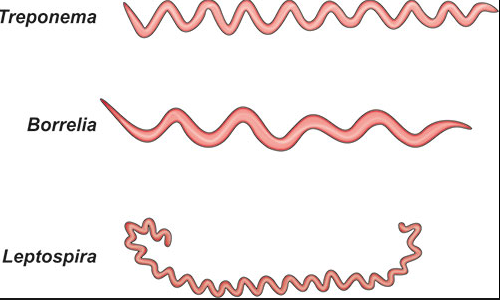Bacterial infections come in various forms, affecting millions worldwide with a range of symptoms and consequences. Among these, Treponema, Borrelia, and Leptospira stand out due to their distinctive characteristics and the unique diseases they cause. Each bacterium belongs to the spirochete family, known for their spiral shapes, but their similarities often end there. Distinguishing between these bacteria is crucial for effective diagnosis and treatment.
Treponema, Borrelia, and Leptospira are fundamentally different in their genetic makeup, modes of transmission, and the diseases they cause. Treponema is primarily known for causing syphilis, a sexually transmitted disease. Borrelia is the culprit behind Lyme disease, typically transmitted through tick bites. Leptospira, on the other hand, is often spread through water contaminated by infected animal urine, leading to leptospirosis.
The need to accurately diagnose and treat diseases caused by these bacteria cannot be overstated. Each requires specific approaches in terms of diagnostics, treatment plans, and prevention strategies. Understanding their differences not only aids in medical practice but also enhances the effectiveness of public health interventions.

Treponema Overview
Characteristics of Treponema
Treponema is a genus within the Spirochaetaceae family, characterized by its distinctive spiral shape, which enables it to move in a corkscrew motion. This motion facilitates its penetration through mucous membranes or skin. The bacterium is microscopic, with a length typically between 6 to 15 microns and about 0.1 to 0.2 microns in diameter. Treponema has a unique cell envelope that differs significantly from typical gram-positive and gram-negative bacteria, which makes it particularly difficult to stain with conventional Gram staining methods.
Diseases Caused
The most notorious disease caused by Treponema is syphilis, primarily transmitted through sexual contact. The disease progresses through several stages:
- Primary syphilis: Characterized by the appearance of a painless ulcer at the infection site.
- Secondary syphilis: Includes a rash over the body, mucous membrane lesions, and lymph node swelling.
- Latent syphilis: Asymptomatic stage that can last for years.
- Tertiary syphilis: Can manifest years after the initial infection, affecting the heart, brain, and other organs.
Treponema pallidum is also associated with other conditions such as bejel, yaws, and pinta—diseases that are primarily found in impoverished regions and are transmitted through nonsexual contact.
Borrelia Overview
Characteristics of Borrelia
Borrelia is another genus of bacteria belonging to the spirochete class, known for causing Lyme disease. These bacteria are larger than Treponema, typically ranging from 10 to 30 microns in length. Borrelia species are unique in their ability to evade the immune system by altering their surface proteins. This ability not only makes them adept at persisting in a host’s body but also complicates vaccine development.
Diseases Caused
Lyme disease is the most prevalent disease caused by Borrelia burgdorferi, transmitted via ticks. The initial symptom is often a circular rash known as erythema migrans, followed by:
- Fever
- Headache
- Fatigue
- Joint pains
If untreated, the infection can spread to joints, the heart, and the nervous system, leading to more severe conditions such as arthritis, carditis, and neurological disorders.
Leptospira Overview
Characteristics of Leptospira
Leptospira are notably thinner spirochetes, with hook-shaped ends. These bacteria are highly motile due to their flagella. They can survive in water or moist soil for weeks to months, which are typical mediums through which humans and animals can become infected.
Diseases Caused
The primary disease caused by Leptospira is leptospirosis. It often manifests with a wide range of symptoms, some of which may be mistaken for other diseases. Symptoms include:
- High fever
- Severe headache
- Chills
- Muscle aches
- Vomiting
In severe cases, leptospirosis can lead to liver damage, kidney failure, meningitis, or respiratory distress, which can be fatal.
Comparative Analysis
Morphological Differences
While all three genera are spirochetes, their morphological differences are significant. Treponema and Borrelia are tightly coiled, whereas Leptospira tends to be thinner with a distinctive hook at each end. These differences are crucial for microscopic diagnosis.
Genomic Contrasts
Treponema and Borrelia have relatively small genomes compared to other bacteria, which reflect their adaptation to a parasitic lifestyle, relying on the host for many nutrients. Leptospira, however, has a larger genome, enabling it to survive outside the host in water or soil.
Habitat and Transmission
Treponema is primarily transmitted through direct contact, especially sexual contact. Borrelia is typically transmitted through tick bites, linking its epidemiology closely with these arthropods. In contrast, Leptospira is often spread through water contaminated by infected animal urine, affecting a wide range of hosts including humans.
Diagnostic Techniques
Detecting Treponema
- Dark field microscopy to visualize live bacteria.
- Serological tests to detect antibodies against the bacterium.
Identifying Borrelia
- PCR testing to identify Borrelia DNA in tissue or fluid samples.
- ELISA and Western blot for antibody detection.
Testing for Leptospira
- Microscopic agglutination test (MAT): The gold standard for detecting Leptospira antibodies.
- Culture methods: Although slower, growing the bacterium in the laboratory helps confirm the diagnosis.

Treatment Strategies
Treponema Treatment Options
Treating infections caused by Treponema pallidum, the bacterium responsible for syphilis, primarily involves the use of antibiotics. Penicillin remains the gold standard for treating all stages of syphilis. The treatment regimen varies depending on the stage of the disease:
- Primary and secondary syphilis: A single intramuscular injection of penicillin G.
- Latent and tertiary syphilis: Requires multiple doses over a longer period to ensure the complete eradication of the pathogen.
For patients allergic to penicillin, alternatives such as doxycycline or azithromycin are considered. It’s crucial to monitor the treatment’s effectiveness through follow-up blood tests, typically at 6 and 12 months.
Borrelia Management Approaches
Lyme disease, caused by Borrelia burgdorferi, is treated with antibiotics as well. The choice of antibiotic and the duration of treatment depend on the stage of the disease:
- Early localized Lyme: Oral antibiotics like doxycycline, amoxicillin, or cefuroxime axetil for 14 to 21 days.
- Disseminated Lyme disease: May require intravenous antibiotics such as ceftriaxone for 14 to 28 days.
Patients are advised to monitor for symptoms of progression or recurrence. Managing the disease effectively also involves supportive therapies to alleviate symptoms like joint pain and fatigue.
Leptospira Therapies
Treatment for leptospirosis is most effective when initiated early. The approach includes:
- Antibiotics: Doxycycline or penicillin in mild cases, and intravenous penicillin or ceftriaxone in severe cases.
- Supportive care: Adequate hydration and treatment of symptoms like muscle pain and fever are critical.
Severe cases, such as Weil’s disease, require hospitalization and intensive care to manage complications like kidney or liver failure.
Epidemiology
Global Prevalence of Treponema
Syphilis remains a significant health concern worldwide, especially in developing countries and among certain high-risk populations in developed nations. The global efforts to eradicate the disease have reduced its prevalence, but it still poses a major public health challenge.
Borrelia Incidence Rates
Lyme disease is the most common tick-borne illness in the Northern Hemisphere, particularly in North America and Europe. Changes in land use, climate change, and increased human interaction with tick-infested areas contribute to its rising incidence.
Leptospira Distribution Patterns
Leptospirosis is most common in tropical and subtropical regions, often associated with water-related activities and occupations. Outbreaks are frequently linked to flooding and exposure to contaminated water.
Prevention and Control
Vaccination and Public Health
While there are no vaccines for Treponema and Borrelia available for human use, ongoing research aims to develop effective vaccinations. For Leptospira, vaccines are available for animals, which help reduce the risk of human disease transmission.
Environmental Management
Reducing the risk of infection involves managing environments to minimize exposure to the pathogens:
- For Lyme disease: Managing deer populations and implementing tick control measures.
- For leptospirosis: Improving sanitation and reducing exposure to contaminated water.
Community Awareness
Raising awareness about the signs, symptoms, and transmission of these diseases is crucial. Public health campaigns and education can significantly reduce the incidence of these infections.
Future Directions
Research Trends
Current research focuses on understanding the genetic and molecular mechanisms of these pathogens to develop better diagnostic tools, treatments, and vaccines. For instance, studies on the surface proteins of Borrelia may lead to breakthroughs in vaccine development.
Technological Advances
Advancements in genomic sequencing and bioinformatics are enhancing our ability to track and predict outbreaks of diseases like Lyme and leptospirosis. These technologies also help in identifying new strains of bacteria, which is crucial for updating treatment protocols and vaccines.
FAQs
What is Treponema?
Treponema is a genus of spirochetes, a type of bacteria characterized by their unique spiral shape. This bacterium is notably responsible for syphilis, a major sexually transmitted infection that can cause long-term complications if not treated properly.
How is Borrelia transmitted?
Borrelia is primarily transmitted to humans through the bite of infected ticks. The most common result of this transmission is Lyme disease, which can manifest in symptoms ranging from rash and fever to neurological complications if left untreated.
What diseases does Leptospira cause?
Leptospira bacteria cause leptospirosis, a disease that affects both humans and animals. Symptoms range from mild, flu-like effects to severe, potentially life-threatening conditions such as Weil’s disease, which can lead to kidney damage, liver failure, and meningitis.
How are these infections diagnosed?
Diagnosing infections caused by Treponema, Borrelia, and Leptospira typically involves serological tests to detect antibodies or molecular techniques like PCR to identify bacterial DNA, aiding in accurate identification and treatment planning.
Conclusion
Recognizing the differences between Treponema, Borrelia, and Leptospira is vital for the medical community and public health officials. Each bacterium presents unique challenges in diagnosis, treatment, and prevention. Accurate identification helps tailor treatment strategies and prevention measures, ultimately reducing the burden of these diseases on global health.
The insights gained from studying these bacteria not only improve individual patient care but also enhance broader epidemiological understanding. This knowledge is crucial for developing targeted therapies and vaccines, making the study of these microorganisms a continually evolving field that holds significant implications for future public health initiatives.

